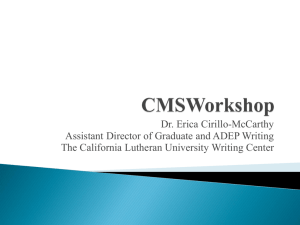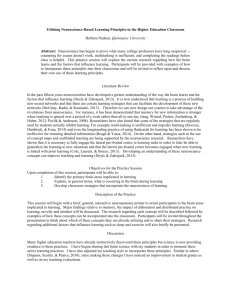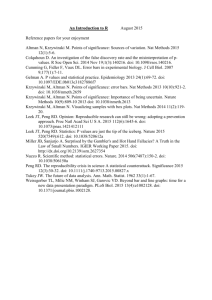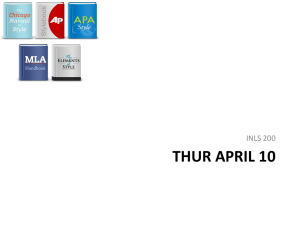Peer Review checklist for research papers
advertisement
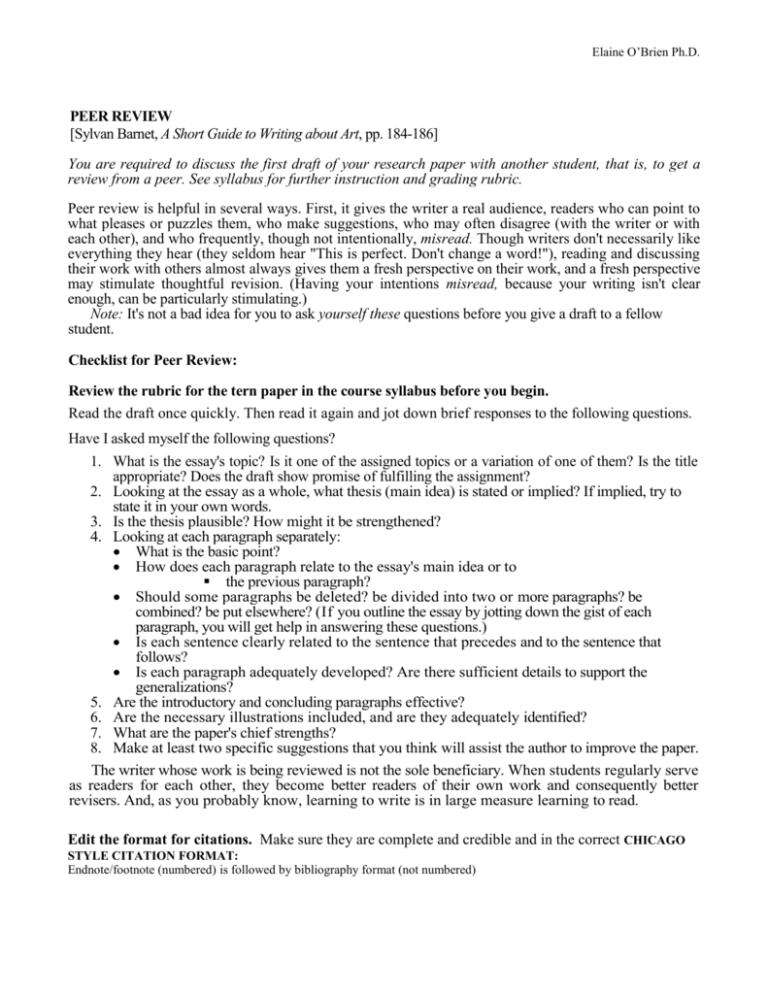
Elaine O’Brien Ph.D. PEER REVIEW [Sylvan Barnet, A Short Guide to Writing about Art, pp. 184-186] You are required to discuss the first draft of your research paper with another student, that is, to get a review from a peer. See syllabus for further instruction and grading rubric. Peer review is helpful in several ways. First, it gives the writer a real audience, readers who can point to what pleases or puzzles them, who make suggestions, who may often disagree (with the writer or with each other), and who frequently, though not intentionally, misread. Though writers don't necessarily like everything they hear (they seldom hear "This is perfect. Don't change a word!"), reading and discussing their work with others almost always gives them a fresh perspective on their work, and a fresh perspective may stimulate thoughtful revision. (Having your intentions misread, because your writing isn't clear enough, can be particularly stimulating.) Note: It's not a bad idea for you to ask yourself these questions before you give a draft to a fellow student. Checklist for Peer Review: Review the rubric for the tern paper in the course syllabus before you begin. Read the draft once quickly. Then read it again and jot down brief responses to the following questions. Have I asked myself the following questions? 1. What is the essay's topic? Is it one of the assigned topics or a variation of one of them? Is the title appropriate? Does the draft show promise of fulfilling the assignment? 2. Looking at the essay as a whole, what thesis (main idea) is stated or implied? If implied, try to state it in your own words. 3. Is the thesis plausible? How might it be strengthened? 4. Looking at each paragraph separately: What is the basic point? How does each paragraph relate to the essay's main idea or to the previous paragraph? Should some paragraphs be deleted? be divided into two or more paragraphs? be combined? be put elsewhere? (If you outline the essay by jotting down the gist of each paragraph, you will get help in answering these questions.) Is each sentence clearly related to the sentence that precedes and to the sentence that follows? Is each paragraph adequately developed? Are there sufficient details to support the generalizations? 5. Are the introductory and concluding paragraphs effective? 6. Are the necessary illustrations included, and are they adequately identified? 7. What are the paper's chief strengths? 8. Make at least two specific suggestions that you think will assist the author to improve the paper. The writer whose work is being reviewed is not the sole beneficiary. When students regularly serve as readers for each other, they become better readers of their own work and consequently better revisers. And, as you probably know, learning to write is in large measure learning to read. Edit the format for citations. Make sure they are complete and credible and in the correct CHICAGO STYLE CITATION FORMAT: Endnote/footnote (numbered) is followed by bibliography format (not numbered) Elaine O’Brien Ph.D. Book One author 1. Michael Pollan, The Omnivore’s Dilemma: A Natural History of Four Meals (New York: Penguin, 2006), 99–100. 2. Pollan, Omnivore’s Dilemma, 3. Pollan, Michael. The Omnivore’s Dilemma: A Natural History of Four Meals. New York: Penguin, 2006. Two or more authors 1. Geoffrey C. Ward and Ken Burns, The War: An Intimate History, 1941–1945 (New York: Knopf, 2007), 52. 2. Ward and Burns, War, 59–61. Ward, Geoffrey C., and Ken Burns. The War: An Intimate History, 1941–1945. New York: Knopf, 2007. Article in a print journal In a note, list the specific page numbers consulted, if any. In the bibliography, list the page range for the whole article. 1. Joshua I. Weinstein, “The Market in Plato’s Republic,” Classical Philology 104 (2009): 440. 2. Weinstein, “Plato’s Republic,” 452–53. Weinstein, Joshua I. “The Market in Plato’s Republic.” Classical Philology 104 (2009): 439–58. Article in an online journal Include a DOI (Digital Object Identifier) if the journal lists one. A DOI is a permanent ID that, when appended to http://dx.doi.org/ in the address bar of an Internet browser, will lead to the source. If no DOI is available, list a URL. Include an access date only if one is required by your publisher or discipline. 1. Gueorgi Kossinets and Duncan J. Watts, “Origins of Homophily in an Evolving Social Network,” American Journal of Sociology 115 (2009): 411, accessed February 28, 2010, doi:10.1086/599247. 2. Kossinets and Watts, “Origins of Homophily,” 439. Kossinets, Gueorgi, and Duncan J. Watts. “Origins of Homophily in an Evolving Social Network.” American Journal of Sociology 115 (2009): 405–50. Accessed February 28, 2010. doi:10.1086/599247.







